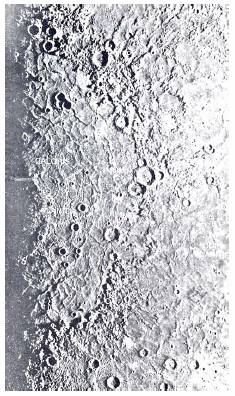Bob Parkinson – Day Return to Mars – and other interesting worlds – 2004
First publication workshop Space: Science, Technology and the Arts in collaboration with ESA/ESTEC, 2004
Abstract
The general purpose of art is to communicate experience. In parallel, tourism attempts to provide the experience – even if in an attenuated and “safe” form. A question frequently asked of astronauts is “what is it like out there?” The question is not so much a matter of “What is it similar to?” as “How do I experience what you experienced?” But in the case of Outer Space some of the experiences are not even accessible to the bravest of astronauts. No astronaut is ever likely to stand on the surface of Venus and view its volcanic peaks. Even on Mars any indications of life are likely to impose planetary quarantine constraints that will limit human exploration. However, we could use unmanned spacecraft to map the surface in sufficient detail to create a “virtual Mars” through which we could wander at will. A full “virtual Mars” enabling individuals to “wander” at will would literally allow ordinary people to see sights which had never been seen before by human eyes. But this is more than a five-minute glimpse of another world. Expectation and imagination – the process of “getting there” – are a part of the total experience. Science can provide the landscape, but art will be necessary to create the experience so that anyone who cares to can become an explorer of the Solar System.
Introduction
A question frequently asked of astronauts is “What is it like out there?” As with Thomas Nagel’s question, “What is it like to be a bat?” [1], the like in this question is not so much a question of “What is it similar to?” as “How can I experience what you experienced?” We cannot all become astronauts; even if that were possible the experience would have to be so routine and safe that the elements of daring and risk, and being first, would have been lost. Nevertheless we want to see things that have never before been seen by human eyes, to experience (even if at second hand) some of the heroism and daring that takes people to new worlds.
But in the case of Outer Space, some of the experiences will not be accessible even to the bravest of astronauts. No human being is ever likely to stand on the surface of Venus and view its volcanic peaks – even if the atmosphere allowed us to do so. Human beings are limited by the need for protection, life support, and the limited range of our senses. However, if we could use unmanned spacecraft to map the surface of other worlds in sufficient detail we could recreate “virtual landscapes” through which ordinary people might wander at will. But imagination also takes a part in the process of exploring other worlds. The science teams know this when they derive billion year histories from the composition of a few, apparently insignificant rocks. The objective of this paper is to think about how we might re-create the experience of exploring other worlds that might otherwise have remained inaccessible to us.
“We shall not cease from exploration” [2]
The land surface area of the Earth is about 149 million km2. Even ignoring those areas that have been re-made by human activity, and the diversity of biological forms that inhabit it, there is still a wide diversity of sites to amaze and inspire the tourist. Mountains, deserts, volcanoes, river valleys, glaciers, open plains, deep canyons – the diversity of our world seems endless. But because we approach them from outside, we tend to think of other worlds as having a typical, single form.
The Moon has a surface area of 38 million km2 – about the same as the continent of Africa. The surface area of Mars is 145 million km2 – almost the same as our own world. On Venus the surface area is 460 million km2 – three time the land area of Earth – and the four Galilean satellites of Jupiter together contribute 223 million km2. There is no reason to suppose that the landscapes of these worlds are not as diverse (and unique) as our own. We already know that our close up views of these worlds have caused us surprises. The apparent volcanic resurfacing of Venus, the massive Aitken Basin at the south pole of the Moon, ancient traces of rivers on Mars, active volcanoes on Io and (quite differently) on Triton, a sub-surface ocean on Europa – each of these was wholly unexpected. Back in the 1950s Chesley Bonestell painted imaginative scenes of what these distant worlds might look like [3], putting miniature spacemen in the foreground to suggest that one day human beings might look on these scenes with their own eyes.
However, not only have our robot spacecraft revealed worlds that are different from those of our imaginations, but the Solar System has proved less hospitable than we had hoped for. Radiation belts about Jupiter, immense pressures and temperatures on Venus, it looks as though human exploration of the Solar System may be limited to the Moon, Mars and a few asteroids. Even on Mars, if we discover life human access to that planet may be severely restricted by considerations of biological contamination. (If we do not discover life on Mars, then the reasons for sending human beings may be insufficient to justify the expense of such an enterprise anyway.)
While the exploits of human beings in Space have been and remain hugely inspiring, the evolution of spaceflight has turned out to be very different from that envisaged by the pioneers back in the 1950s. Forty-five years after the first manned flight, apart from a few brief years when a dozen men stood briefly on the Moon, our human activities are still limited to low Earth orbit. Robot missions, on the other hand, have been hugely successful. We have visited all the worlds of our Solar System with the exception of Pluto and mapped most of them in close up.
For those who design these missions and help them to fly, the emotional experience must be as intense as for human explorers of new worlds. Not only do these explorers see (through robot eyes) new and spectacular landscapes for the first time, but also there is a deeper experience that comes from discovering and understanding what it is that we encounter. What we see is not always obvious. Linda Morabito, who was the first person to see an active volcano on Io, was not even one of the science team but an optical navigation engineer who first of all through that she had seen a star rising behind Io [4].
One of my personal favourites is the Caloris basin on Mercury (Fig. 1), imaged by the Mariner 10 mission back in 1974. At first this looks like just another impact basin like those on our Moon until you understand the dynamics of the event that formed it. Caloris was probably the result of a collision with Mercury by an asteroid 50 – 70 km in diameter at an impact velocity of about 50 km/s. The effects of the impact went completely around the planet, creating particular terrain features on the far side as the shock-waves crossed and re-crossed one another. The fireball must have reached a temperature of one million degrees, and for a dozen seconds or so Mercury was actually the brightest object in the Solar System – including the Sun! The radiation melted the surface in depth from horizon to horizon – the 1300 km that defines the edges from which that 50 km fireball could be seen.
I included Caloris in one of my paintings, entitled “The Impact is All Inside Your Head.” The question is, how to we provide that experience for the general public?

Becoming Nagel's bat
We cannot all become astronauts and fly to Mars. But it might be possible to let ordinary individuals effectively stand where no human has stood to look before through the medium of Virtual Tourism [5].
The Mars Reconnaissance Orbiter, scheduled for a 2005 launch, will have the capability to map Mars down to a resolution of 20 cm [6]. At 50 Mbps it would take about 37 years to map the entire Martian surface in this way, but let us suppose that we could (with a higher data rate link), and combine it with some “ground truth” investigations to produce a complete “virtual map” of Mars. Rather than just using it for scientific investigations, it would then be possible to allow casual visitors to wander through any areas that they chose, genuinely seeing sights that had never before been seen by human eyes.
Virtual tourism would differ from simple “fly through” visualizations that already exist by allowing the visitor to make a choice about their viewpoint and route. They would then become true explorers – without having to disrupt the Martian environment. Furthermore, the same process could be carried out for Venus, Mercury, the Galilean satellites and anywhere else that we might care to go.
Wubbo Ockels suggested that human exploration of the Solar System might have to go this way in any case, with the astronaut explorers being confined to orbit and carrying out their mission through remote teleoperation [7].
We are becoming used to seeing through machine eyes. Neal Stephenson [8] recounts visiting Main Street USA at Disney World – itself a recreation of a bygone town – and seeing a man watching it through the display screen of his camcorder. “Rather than go see a real small town for free, he had paid money to see a pretend one, and rather than see it with the naked eye he was watching it on television.” Furthermore, Stephenson admits, “and rather than stay home and read a book, I was watching him.”
The issue becomes still more complicated when we recognize that the pictures that we see of Mars, or the planets, or other astronomical objects (e.g. from Hubble) are already interpreted. Rather than isolating us from reality, the interpreted images give us a deeper insight. The eye does not see in exactly the same way as the camera – it has a different range, a different sensitivity, and a different idea about “colour”. (A camera does not have any idea about colour, but we do.) Pictures from Mars are adjusted so that they “look right.” Pictures from Hubble are almost inevitably in “false colour” because there is so much more information about what we are looking at that way. The pictures are interpreted by a machine, but the instructions are given by human beings so that other human beings can appreciate them. In addition, the significance of what is seen is dependent upon what we already know. What may appear to the untrained eye as a featureless wilderness becomes fascinating to the expert for what it reveals. Ordinary people require guides – on Earth as much as on other worlds.
Interestingly much of US “Space Art” consists of realistic artist’s impressions of landscapes and hardware intended to reproduce “what we might see” – despite the difficulties noted above. The old Soviet “Space Art” on the other hand seems to have spent more time with significance and the emotional response to the events of the Space Age. [9]
Clearly, if we create a virtual image of Mars and allow people to wander freely, every location on Mars will not be as interesting. The pioneers will scout out the dramatic vistas, and the tourists will follow, having the best routes mapped out for them and the significance of the sites explained. As with all varieties of tourism, expectations and the process of “getting there” are all a part of the experience. Pictures alone may not be sufficient – we need things that we can hear and smell and touch, and those sort of things are difficult in a Martian environment (even for real live astronauts, encased in their biologically isolating pressure suits). But to be successful, the experience has somehow to exceed the expectations.
It occurs to me that part of the experience of awe that we have before wilderness and mountain landscapes is the feeling of nakedness before the vastness of infinity. The poet Rilke expressed it thus (in a somewhat different context):
“For Beauty’s nothing
But the beginning of Terror we’re still just able to bear,
And why we adore it so is because it serenely
Distains to destroy us.” [10]
(Incidentally, if we re-interpret Thomas Nagel’s question in more experiential terms, and ask, “What is it like to see as a bat?” the answer turns out to be a little disappointing. Recent research has indicated that the neurons in that part of a bat’s brain responsible for echolocation are connected together in a way very similar to humans’ visual cortex [11]. It appears that a bat’s echolocation sense returns images rather like those provided by the human eye.)
Mounting Philostratus' horse
Philostratus, writing on the subject of painting ~170 AD, commented, “No one can understand the painted horse or bull unless he knows what such creatures are like.” [12] Outer space is unfamiliar territory; we do not know what its horses are like. Furthermore, the excitement that the workers in the field experience is not simply a matter of information; it involves a whole variety of human experiences (including working through the night in order to resolve some problem or getting a proposal delivered).
Fortunately, when it comes to other human beings, we have developed a certain expertise in answering the question, “What is it like to be you?” Art is about communicating experience. Tourism attempts to provide the experience – albeit in a safe and sanitized manner. But the experience is also concerned with significance. The European world tended to ignore its mountains and wilderness areas until the Romantics of the early 19th Century gave them emotional significance. In the same way Space Tourism, particularly in those areas not immediately accessible to sub-orbital rockets, is going to involve rather more than being able to go there – either in reality or through virtual images. The images also have to feed the imagination. We need to be able to see not only through the eyes of our astronauts and robot explorers, but also through the imaginations of the scientists and explorers who are discovering worlds that we can never visit “in the flesh.” Straightforward artist’s impressions are not enough, we need to recreate the experience as well.
When I first read about Philostratus’ horse I realized that there was a paradox. The sort of painting that deals with familiar objects and landscapes is comforting and sells well at local Art Shows. But great art takes us beyond the familiar into unfamiliar territories, sharing novel experiences and expanding our horizons. Arthur C. Clarke, writing in 1946 [13] on the impact of spaceflight on human society, commented that historically the periods of external expansion and exploration have also been periods of intellectual progress and the flowering of the arts and science. Here the interaction between Space and Art is potentially at its most significant.
It isn’t our bodies that we need to take to Mars -it is our consciousness. In the long run this may be the only way that we can explore the Universe [14]. Virtual Tourism would allow us at least to fulfil the dictum of the eco-tourist: “Take only pictures, leave only footprints.”
References
1. Thomas Nagel, “What is it like to be a bat?”, Philosophical Review, 83, pp. 435-50 (October 1974)
2. T.S.Eliot, “Little Gidding”, “The Four Quartets” (Faber & Faber, London, 1959)
3. Chesley Bonestell & Willy Ley, “The Conquest of Space”, (Sidgwick & Jackson, London, 1950)
4. David Morrison & Jane Samz, Voyage to Jupiter”, NASA SP-439 (1980) p. 86 et.seq.
5. Bob Parkinson, “Shaping the Flux – the Myth of the Future in Spaceflight”, IAA-97-IAA.8.2.01, 48th International Astronautical Congress, Torino, Italy, Oct 1997
6. “Mars Reconnaissance Orbiter” http://nssdc.gsfc.nasa.gov/planetary/mars_2003_05.html
7. Wubbo Ockels, “Remote/Robot Interactive Space Exploration – RISE tele-exploration”, Space 2020 Round Table, ESTEC June 28/29, 1995
8. Neal Stephenson, “In the Beginning was the Command Line”
9. W.K.Hartmann, A.Sokolov, R. Miller & V.Myagkov (Eds.), In the Stream of Stars, (Workman Publishing, New York, 1990)
10. Rainer Maria Rilke, “Duineser Elegien” (1923): Translation by J.B.Leishman (Penguin Books Ltd., Harmondsworth, 1964)
11. Terry Pratchett, Ian Stewart & Jack Cohen, “The Globe”, (Ebury Press, London, 2002) p. 287
12. E.H.Gombrich, “Art & Illusion”, (Phaidon Press, London, 1959)
13. Arthur C. Clarke, “The Challenge of the Spaceship (Astronautics and its Impact Upon Human Society)”, JBIS, 6, pp. 66-78 (1946), reprinted in Space Chronicle, JBIS, 56 Suppl.1, pp.15-23 (2003)
14. Bob Parkinson, “Thoughts on the Evolution of Consciousness”, JBIS, 57, pp. 60-66 (2004)
© Bob PARKINSON & Leonardo/Olats, mai 2004, republished 2023
Leonardo/Olats
Observatoire Leonardo des Arts et des Techno-Sciences
À propos / About



Pour toute (re)publication, merci de contacter / For any (re)publication, please contact Annick Bureaud: info@olats.org
Pour toute question concernant le site, merci de contacter / For any issue about the website, please contact: webmaster@olats.org
Design Thierry Fournier
© Association Leonardo 1997-2022